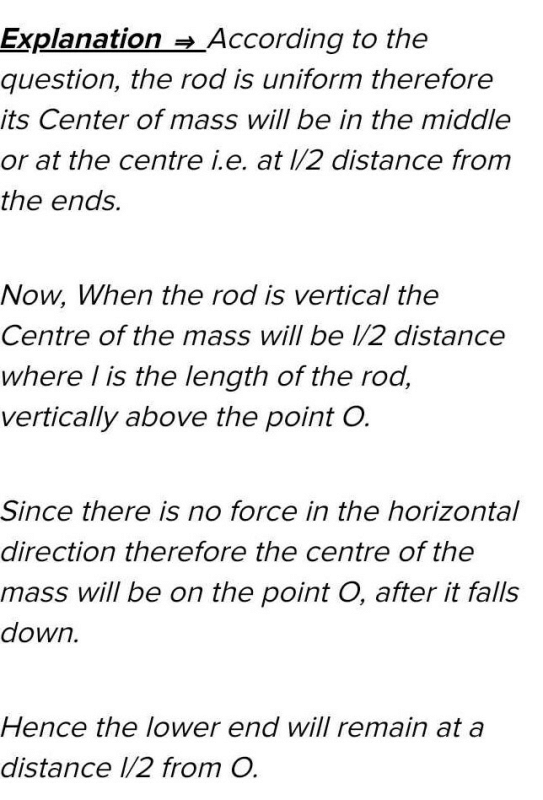JEE Exam > JEE Questions > A uniform rod is kept vertically on a horizon...
Start Learning for Free
A uniform rod is kept vertically on a horizontal smooth surface at a point O. If it is rotated slightly and released, it falls down on the horizontal surface. The lower end will remain at.?
Most Upvoted Answer
A uniform rod is kept vertically on a horizontal smooth surface at a p...

Community Answer
A uniform rod is kept vertically on a horizontal smooth surface at a p...
Introduction:
When a uniform rod is kept vertically on a horizontal smooth surface and then rotated slightly and released, it falls down on the horizontal surface. In this scenario, the lower end of the rod will remain at the same position on the horizontal surface where it was initially placed. This behavior can be understood by analyzing the forces acting on the rod and the concept of torque.
Explanation:
1. Initial State:
- The rod is kept vertically on a horizontal smooth surface.
- Let the lower end of the rod be denoted as point O, which is in contact with the surface.
- The rod is in equilibrium in this initial state, with no net forces or torques acting on it.
2. Rotation and Release:
- When the rod is rotated slightly and released, it starts to fall down due to the force of gravity acting on it.
- The rod experiences a clockwise torque about point O, caused by the gravitational force acting on its center of mass.
- This torque causes the rod to rotate in a clockwise direction, leading to its downward motion.
3. Conservation of Angular Momentum:
- As the rod falls down, it conserves its angular momentum.
- The initial angular momentum of the rod is zero since it is at rest.
- As the rod falls, its rotational inertia decreases due to the change in its orientation. However, its angular velocity increases to compensate for the decrease in rotational inertia, thus conserving the angular momentum.
4. Lower End Position:
- The lower end of the rod (point O) remains at the same position on the horizontal surface where it was initially placed.
- This occurs because the torque acting on the rod is only due to the gravitational force acting on its center of mass.
- The center of mass of the rod lies somewhere along the length of the rod, and it is this point that falls down and rotates about point O.
- However, the lower end of the rod (point O) does not experience any torque, as it is the point of contact with the surface.
- Therefore, the lower end remains stationary on the horizontal surface.
5. Conclusion:
In conclusion, when a uniform rod is kept vertically on a horizontal smooth surface and then rotated slightly and released, it falls down on the horizontal surface. The lower end of the rod remains at the same position on the horizontal surface where it was initially placed. This occurs because the lower end does not experience any torque and remains stationary due to its contact with the surface.
When a uniform rod is kept vertically on a horizontal smooth surface and then rotated slightly and released, it falls down on the horizontal surface. In this scenario, the lower end of the rod will remain at the same position on the horizontal surface where it was initially placed. This behavior can be understood by analyzing the forces acting on the rod and the concept of torque.
Explanation:
1. Initial State:
- The rod is kept vertically on a horizontal smooth surface.
- Let the lower end of the rod be denoted as point O, which is in contact with the surface.
- The rod is in equilibrium in this initial state, with no net forces or torques acting on it.
2. Rotation and Release:
- When the rod is rotated slightly and released, it starts to fall down due to the force of gravity acting on it.
- The rod experiences a clockwise torque about point O, caused by the gravitational force acting on its center of mass.
- This torque causes the rod to rotate in a clockwise direction, leading to its downward motion.
3. Conservation of Angular Momentum:
- As the rod falls down, it conserves its angular momentum.
- The initial angular momentum of the rod is zero since it is at rest.
- As the rod falls, its rotational inertia decreases due to the change in its orientation. However, its angular velocity increases to compensate for the decrease in rotational inertia, thus conserving the angular momentum.
4. Lower End Position:
- The lower end of the rod (point O) remains at the same position on the horizontal surface where it was initially placed.
- This occurs because the torque acting on the rod is only due to the gravitational force acting on its center of mass.
- The center of mass of the rod lies somewhere along the length of the rod, and it is this point that falls down and rotates about point O.
- However, the lower end of the rod (point O) does not experience any torque, as it is the point of contact with the surface.
- Therefore, the lower end remains stationary on the horizontal surface.
5. Conclusion:
In conclusion, when a uniform rod is kept vertically on a horizontal smooth surface and then rotated slightly and released, it falls down on the horizontal surface. The lower end of the rod remains at the same position on the horizontal surface where it was initially placed. This occurs because the lower end does not experience any torque and remains stationary due to its contact with the surface.

|
Explore Courses for JEE exam
|

|
Similar JEE Doubts
Question Description
A uniform rod is kept vertically on a horizontal smooth surface at a point O. If it is rotated slightly and released, it falls down on the horizontal surface. The lower end will remain at.? for JEE 2025 is part of JEE preparation. The Question and answers have been prepared according to the JEE exam syllabus. Information about A uniform rod is kept vertically on a horizontal smooth surface at a point O. If it is rotated slightly and released, it falls down on the horizontal surface. The lower end will remain at.? covers all topics & solutions for JEE 2025 Exam. Find important definitions, questions, meanings, examples, exercises and tests below for A uniform rod is kept vertically on a horizontal smooth surface at a point O. If it is rotated slightly and released, it falls down on the horizontal surface. The lower end will remain at.?.
A uniform rod is kept vertically on a horizontal smooth surface at a point O. If it is rotated slightly and released, it falls down on the horizontal surface. The lower end will remain at.? for JEE 2025 is part of JEE preparation. The Question and answers have been prepared according to the JEE exam syllabus. Information about A uniform rod is kept vertically on a horizontal smooth surface at a point O. If it is rotated slightly and released, it falls down on the horizontal surface. The lower end will remain at.? covers all topics & solutions for JEE 2025 Exam. Find important definitions, questions, meanings, examples, exercises and tests below for A uniform rod is kept vertically on a horizontal smooth surface at a point O. If it is rotated slightly and released, it falls down on the horizontal surface. The lower end will remain at.?.
Solutions for A uniform rod is kept vertically on a horizontal smooth surface at a point O. If it is rotated slightly and released, it falls down on the horizontal surface. The lower end will remain at.? in English & in Hindi are available as part of our courses for JEE.
Download more important topics, notes, lectures and mock test series for JEE Exam by signing up for free.
Here you can find the meaning of A uniform rod is kept vertically on a horizontal smooth surface at a point O. If it is rotated slightly and released, it falls down on the horizontal surface. The lower end will remain at.? defined & explained in the simplest way possible. Besides giving the explanation of
A uniform rod is kept vertically on a horizontal smooth surface at a point O. If it is rotated slightly and released, it falls down on the horizontal surface. The lower end will remain at.?, a detailed solution for A uniform rod is kept vertically on a horizontal smooth surface at a point O. If it is rotated slightly and released, it falls down on the horizontal surface. The lower end will remain at.? has been provided alongside types of A uniform rod is kept vertically on a horizontal smooth surface at a point O. If it is rotated slightly and released, it falls down on the horizontal surface. The lower end will remain at.? theory, EduRev gives you an
ample number of questions to practice A uniform rod is kept vertically on a horizontal smooth surface at a point O. If it is rotated slightly and released, it falls down on the horizontal surface. The lower end will remain at.? tests, examples and also practice JEE tests.

|
Explore Courses for JEE exam
|

|
Signup to solve all Doubts
Signup to see your scores go up within 7 days! Learn & Practice with 1000+ FREE Notes, Videos & Tests.





















